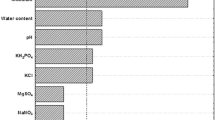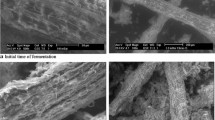Abstract
Commercial cellulase production has increased in recent years and consistent research has been carried out to improve levels of β-glucosidase. Bioprocesses have been successfully adapted to produce this enzyme, with solid-state fermentations as the best-suited technique involving fungi. The aim of this study was to use leaves of tarbush (Flourensia cernua), an abundant shrub of the Chihuahuan Desert, as a carbon source for β-glucosidase production by Aspergillus niger. During the solid bioprocess, this enzyme reached its peak production at 36 h of culture with 3876.6 U/L. There is a particular interest in the substrate composition because of the possibility of phenolic glycosides having an important role in β-glucosidase production. HPLC–MS analyses showed that glycosides were present with the highest accumulation at 36 h of fungal culture. Luteolin and apigenin glycosides [1.8 and 2.4 absorbance units, respectively] were also detected and showed their highest point of detection alongside the highest β-glucosidase activity. No apparent changes in cellulose were observed, while hemicellulose content decreased, which could be related to production and activity of β-glucosidase. This study shows that leaves of F. cernua are an important raw material for β-glucosidase production and give a source of compounds of added value which also may have an important role for β-glucosidase production.





Similar content being viewed by others
References
Aguilar-Zárate P (2016) Purification and characterization of an ellagitannase of Aspergillus niger GH1. Universidad Autónoma de Coahuila. Doctoral thesis
Ascacio-Valdés JA, Buenrostro J, De la Cruz R, Sepúlveda L, Aguilera A, Prado A, Contreras J, Rodríguez R, Aguilar CN (2014) Fungal biodegradation of pomegranate ellagitannins. J Basic Microbiol 54:28–34
Ascacio-Valdés J, Aguilera-Carbó AF, Buenrostro J, Prado-Barragán P, Rodríguez-Herrera R, Aguilar CN (2016) The complete biodegradation pathway of ellagitannins by Aspergillus niger in solid-state fermentation. J Basic Microbiol 56:329–336
Behera S, Ray R (2015) Solid state fermentation for production of microbial cellulases: recent advances and improvement strategies. Int J Biol Macromol 86:656–669
Buck A, Casciatori F, Thoméo J, Tsotsas E (2015) Model-based control of enzyme yield in solid-state fermentation. Procedia Eng 102:362–371
Celep GS, Rastmanesh R, Marotta F (2014) Microbial metabolism of polyphenols and health. In: Watson RR, Preedy VR, Zibadi S (eds) Polyphenols in human health and disease. Academic, San Diego, pp 577–589
Cruz M, Sánchez J (2000) La fibra en la alimentación del ganado lechero. Nutrición Anim Trop 6:39–74
Cui P, Li T, Ping L, Sun W (2016) Highly selective and efficient biotransformation of linarin to produce tilianin by naringinase. Biotechnol Lett 38:1367–1373
De León-Zapata MA, Sáenz A, Jasso-Cantú D, Rodríguez R, Pandey A, Aguilar CN (2013) Fermented Flourensia cernua extracts and their in vitro assay against Penicillium expansum and Fusarium oxysporum. Food Technol Biotechnol 51:233–239
De León-Zapata MA, Pastrana-Castro L, Rua-Rodríguez M, Alvarez-Pérez O, Rodríguez-Herrera R, Aguilar CN (2016) Experimental protocol for the recovery and evaluation of bioactive compounds of tarbush against postharvest fruit fungi. Food Chem 198:62–67
de Rodríguez DJ, Hernández D, Solís S, Rodríguez R, Rodríguez R (2012) Flourensia cernua D.C: a plant from Mexican semiarid regions with a broad spectrum of action for disease control, integrated pest management and pest control—current and future tactics. In Tech. doi:10.5772/1383
Dey T, Kuhad R (2014) Enhanced production and extraction of phenolic compounds from wheat by solid-state fermentation with Rhizopus oryzae RCK2012. Biotechnol Rep 4:120–127
El-Bakry M, Abraham J, Cerda A, Barrena R, Gea T, Sánchez A (2015) From wastes to high value added products: novel aspects of SSF in the production of enzymes. Crit Rev Environ Sci Tec 45:1999–2042
Estell RE, James DK, Fredrickson EL, Anderson DM (2013) Within-plant distribution of volatile compounds on the leaf surface of Flourensia cernua. Biochem Syst Ecol 48:144–150
Estell R, Anderson D, James D (2016) Defoliation of Flourensia cernua (tarbush) with high-density mixed-species stockings. J Arid Environ 130:62–67
Fu Y, Liu W, Zu Y, Tong M, Li S, Yan M, Efferth T, Luo H (2008) Enzyme assisted extraction of luteolin and apigenin from pigeonpea [Cajanus cajan (L.) Millsp.] leaves. Food Chem 111:508–512
Gómez-García R (2016) Study of recovery of enzymes industrial interest (cellulases, xylanases and invertases) using flexible-chain polymers. Universidad Autónoma de Coahuila. Bachelor science thesis
Graminha E, Goncalves A, Pirota R, Balsalobre M, Da Silva R, Gomez E (2008) Enzyme production by solid-state fermentation: application to animal nutrition. Anim Feed Sci Technol 144:1–22
Grujić M, Dojnov B, Potočnik I, Duduk B, Vujčić Z (2015) Spent mushroom compost as substrate for the production of industrially important hydrolytic enzymes by fungi Trichoderma spp. and Aspergillus niger in solid state fermentation. Int Biodeterior Biodegrad 104:290–298
Hansen G, Lübeck M, Frisvad J, Lübeck P, Andersen B (2015) Production of cellulolytic enzymes from ascomycetes: comparison of solid state and submerged fermentation. Process Biochem 50:1327–1341
Hölker U, Hofer M, Lenz J (2004) Biotechnological advantages of laboratory-scale solid-state fermentation with fungi. Appl Microbiol Biotechnol 64:175–186
Huerta I (2015) Chemical characterization and fungal fermentation of semidesert plants with animal feed potential. Mexico: Universidad Autónoma Agraria Antonio Narro. Dissertation
Hyder P, Fredrickson E, Estell R, Lucero M, Remmenga M (2005) Loss of phenolic compounds from leaf litter of creosotebush [Larrea tridentata (Sess. & Moc. ex DC.) Cov.] and tarbush (Flourensia cernua DC.). J Arid Environ 61:79–91
Kris-Etherton PM, Hecker KD, Bonanome A, Coval SM, Binkoski AE, Hilpert KF (2002) Bioactive compounds in foods: their role in the prevention of cardiovascular disease and cancer. Am J Med 113:71S–88S
Liu D, Zhang R, Yang X, Zhang Z, Song S, Miao Y, Shen Q (2012) Characterization of a thermostable β-glucosidase from Aspergillus fumigatus Z5, and its functional expression in Pichia pastoris X33. Microb Cell Fact 11:1–15
Lowry O, Rosebrough N, Farr A, Randall R (1951) Protein measurement with the Folin phenol reagent. J Biol Chem 193:265–275
Lu X, Sun J, Nimtz M, Wissing J, Zeng A, Rinas U (2010) The intra- and extracellular proteome of Aspergillus niger growing on defined medium with xylose or maltose as carbon substrate. Microb Cell Fact 9:1–13
Lynd L, Weimer P, Van Zyl W, Pretorius L (2002) Microbial cellulose utilization: fundamentals and biotechnology. Microbiol Molec Biol Rev 66:506–577
Martins S, Mussatto SI, Martínez-Avila G, Montañez-Saenz J, Aguilar CN, Teixeira JA (2011) Bioactive phenolic compounds: production and extraction by solid-state fermentation. A review. Biotechnol Adv 29(3):365–373
Mellado M, Olivares L, Pittroff W, Díaz H, López R, Villarreal JA (2007) Oral morphology and dietary choices of goats on rangeland. Small Rumin Res 71:194–199
Nava-Cruz NY, Contreras-Esquivel JC, Aguilar-González MA, Nuncio A, Rodríguez-Herrera R, Aguilar CN (2016) Agave atrovirens fibers as substrate and support for solid-state fermentation for cellulase production by Trichoderma asperellum. 3 Biotech 6:115
Pandey CR, Soccol D, Mitchell DA (2000) New developments in solid state fermentation: I-bioprocesses and products. Process Biochem 35:1153–1169
Phitsuwan P, Laohakunjit N, Kerdchoechuen O, Kyu K, Ratanakhanokchai K (2013) Present and potential applications of cellulases in agriculture, biotechnology, and bioenergy. Folia Microbiol 58:163–176
Rani V, Mohanram S, Tiwari R, Nain L, Arora A (2014) Beta-glucosidase: key enzyme in determining efficiency of cellulase and biomass hydrolysis. J Bioprocess Biotech 5:1–8
Singhania RR, Sukumaran RK, Patel AK, Larroche C, Pandey A (2010) Advancement and comparative profiles in the production technologies using solid-state and submerged fermentation for microbial cellulases. Enzyme Microb Technol 46:541–549
Sukumaran RK, Singhania RR, Mathew GM, Pandey A (2009) Cellulase production using biomass feed stock and its application in lignocellulose saccharification for bio-ethanol production. Renew Energy 34:421–424
Thomas L, Larroche C, Pandey A (2013) Current developments in solid-state fermentation. Biochem Eng J 81:146–161
Van Munster JM, Daly P, Delmas S, Pullan ST, Blythe MJ, Malla S, Kokolski M, Noltorp ECM, Wennberg K, Fetherston R, Beniston R, Yu X, Dupree P, Archer DB (2014) The role of carbon starvation in the induction of enzymes that degrade plant-derived carbohydrates in Aspergillus niger. Fungal Genet Biol 72:34–47
Van Soest PJ, Robertson JB, Lewis BA (1991) Polysaccharides in relation to animal nutrition. J Dairy Sci 74:3583–3597
Vattem DA, Shetty K (2003) Ellagic acid production and phenolic antioxidant activity in cranberry pomace (Vaccinium macrocarpon) mediated by Lentinus edodes using a solid-state system. Process Biochem 39:367–379
Veitch NC, Grayer RJ (2008) Flavonoids and their glycosides, including anthocyanins. Nat Prod Rep 25:555–611
Ventura J, Belmares R, Aguilera-Carbo A, Gutiérrez-Sanchez G, Rodríguez-Herrera R, Aguilar CN (2008) Fungal biodegradation of tannins from creosote bush (Larrea tridentata) and tar bush (Flourensia cernua) for gallic and ellagic acid production. Food Technol. Biotechnol. 46:213–217
Villas-Bôas SG, Esposito E, Mitchell DA (2002) Microbial conversion of lignocellulosic residues for production of animal feeds. Anim Feed Sci Technol 98:1–12
Wang M, Liu K, Dai L, Zhang J, Fang X (2013) The structural and biochemical basis for cellulose biodegradation. J Chem Technol Biotechnol 88:491–500
Wong-Paz J, Contreras-Esquivel J, Rodríguez-Herrera R, Carrillo M, López L, Nevárez V, Aguilar C (2015) Total phenolic content, in vitro antioxidant activity and chemical composition of plant extracts from semiarid Mexican region. Asian Pac J Trop Med 8:104–111
Yoon LW, Ang TN, Ngoh GC, Chua ASM (2014) Fungal solid-state fermentation and various methods of enhancement in cellulase production. Biomass Bioenerg 67:319–338
Acknowledgements
The authors would like to thank the National Council of Science and Technology (CONACyT) for providing a scholarship and financial support.
Author information
Authors and Affiliations
Corresponding author
Ethics declarations
Conflict of interest
The authors declare that there is no conflict of interest.
Rights and permissions
About this article
Cite this article
Lopez-Trujillo, J., Medina-Morales, M.A., Sanchez-Flores, A. et al. Solid bioprocess of tarbush (Flourensia cernua) leaves for β-glucosidase production by Aspergillus niger: initial approach to fiber–glycoside interaction for enzyme induction. 3 Biotech 7, 271 (2017). https://doi.org/10.1007/s13205-017-0883-6
Received:
Accepted:
Published:
DOI: https://doi.org/10.1007/s13205-017-0883-6




